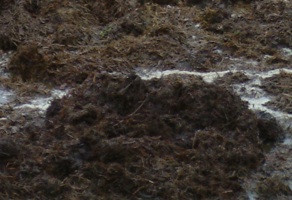
 September 10, 2008, Hereford, TX –
September 10, 2008, Hereford, TX –
Manure may not be as stable or spreadable as commercial fertilizer, but
it is right on the price, a Texas AgriLife Extension Service specialist
said.
September 10, 2008, Hereford, TX – Manure may not be as stable or spreadable as commercial fertilizer, but it is right on the price, a Texas AgriLife Extension Service specialist said.
 “When we apply manure, it comes out in chunks and we don’t know the exact analysis,” said Dr. Sam Feagley, AgriLife Extension soil environmental specialist. “But now economics are overriding convenience, and producers even farther from feedyards are considering the benefits of applying manure.”
“When we apply manure, it comes out in chunks and we don’t know the exact analysis,” said Dr. Sam Feagley, AgriLife Extension soil environmental specialist. “But now economics are overriding convenience, and producers even farther from feedyards are considering the benefits of applying manure.”
Feagley spoke at a recent feedyard manure educational meeting in Hereford, Texas. Attendees included farmers, crop consultants, feedyard managers and custom manure haulers.
“The agronomic value of manure has been known for a long time, and the organic content of manure provides many benefits to soils that cannot be obtained from commercial fertilizers alone,” Feagley said.
A bag of commercial fertilizer only provides what is listed on the bag, but manure will provide nitrogen, as well as phosphorus, potassium, calcium, magnesium, sulfur, iron, manganese, copper, zinc and all the other essential plant nutrients, he said.
“As fertilizer gets much more expensive, manure is a great value,” Feagley said. “Depending on the nutrients in the manure that you need, that value goes up. If you need phosphorus and potassium in addition to nitrogen, you add to the value.”
Feagley recommended producers meet the nitrogen needs of their crop when applying manure, and remember to take into account the mineralization rate. With mineralization, only about 45 percent of the nitrogen, 75 percent of the phosphorus and 90 percent of the potassium is available the first year, he said. An additional 5 to 10 percent is available the second year and another 3 to 5 percent the third year.
Fertilization rates recommended for two-bale-per-acre cotton are 100 pounds of nitrogen, 105 pounds of phosphorus and 120 pounds of potassium. The rates for 40- to 59-bushel-per-acre wheat are 120 pounds of nitrogen, 75 of phosphorus and 125 of potassium, assuming no nutrients are available to the crops, Feagley said.
During the meeting, Ben Weinheimer, Texas Cattle Feeders Association vice president, unveiled a new online Manure Value Calculator that can easily determine the economic value of manure compared to commercial fertilizer costs. To access the calculator, go to: http://www.tcfa.org/forms/ManureVsFert/manure_value_calculator.html.
In meeting the nitrogen needs and calculating manure application, Feagley said, producers need to be aware of how much extra phosphorus and potassium they are getting.
To avoid problems, producers need to apply manure at the needed nitrogen rate through the third year taking mineralization into account, he said. But after the third year, do not take mineralization into account and apply at the nitrogen rate every two or three years, supplementing with commercial fertilizer in years two and three.
Also, Feagley said, producers need to keep in mind any possible runoff into surface water bodies, such as a pond or stream, as the phosphorus has the potential to increase the eutrophication process.
Eutrophication is the natural weathering process of a surface water body. When additional nutrients, such as phosphorus, are increased in the water, then the extra nutrients can lead to overgrowth of plants and decreased dissolved oxygen in the water column.
“Know what you are getting with your manure,” he said.
Manure quality, while still not consistent, is better than in the past because feedyard owners know how to scrape the pens and get less dirt and cement, in the mix, he said. The inclusion of unwanted seeds, trash and soil, and its slow release of nutrients, are considered drawbacks.
However, the advantages to applying manure, Feagley said, are it maintains the organic matter and adds all essential plant nutrients to the soil. This helps the soil-air-water relationship, improves soil drainage and the plant-available water-holding capacity of the soil.
Manure is valued by comparing it to inorganic fertilizers, Feagley said. It is one-third to one-half as expensive as commercial fertilizer over a four-year period.
“Some producers are hauling it up to 20 miles, where three years ago haulers wouldn’t go more than five miles,” he said.